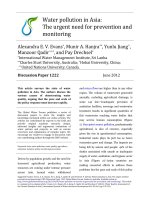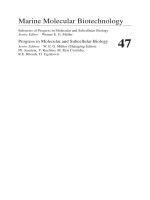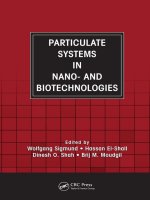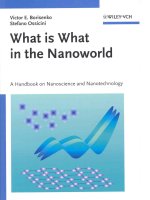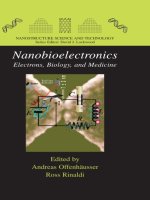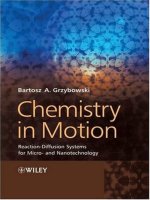- Trang chủ >>
- Khoa Học Tự Nhiên >>
- Vật lý
chemistry in motion. reaction–diffusion systems for micro- and nanotechnology, 2009, p.305
Bạn đang xem bản rút gọn của tài liệu. Xem và tải ngay bản đầy đủ của tài liệu tại đây (6.45 MB, 305 trang )
Chemistry in Motion:
Reaction–Diffusion Systems for
Micro- and Nanotechnology
Bartosz A. Grzybowski
Northwestern University, Evanston, USA
Chemistry in Motion
Chemistry in Motion:
Reaction–Diffusion Systems for
Micro- and Nanotechnology
Bartosz A. Grzybowski
Northwestern University, Evanston, USA
This edition first published 2009
# 2009 John Wiley & Sons Ltd.
Registered office
John Wiley & Sons Ltd, The Atrium, Southern Gate, Chichester, West Sussex, PO19 8SQ, United Kingdom
For details of our global editorial offices, for customer services and for information about how to apply for
permis sion to reuse the copyr ight material in this book please see our website at www. wiley.com.
The right of the author to be identified as the author of this work has been asserted in accordance with the
Copyright, Designs and Patents Act 1988.
All rights reserved. No part of this publication may be reproduced, stored in a retrieval system, or transmitted, in
any form or by any means, electronic, mechanical, photocopying, recording or otherwise, except as permitted by
the UK Copyright, Designs and Patents Act 1988, without the prior permission of the publisher.
Wiley also publishes its books in a variety of electronic formats. Some content that appears in print may not be
available in electronic books.
Designations used by companies to distinguish their products are often claimed as trademarks. All brand names and
product names used in this book are trade names, service marks, trademarks or registered tradema rks of their
respective owners. The publisher is not associated with any product or vendor mentioned in this book. This
publication is designed to provide accurate and authoritative information in regard to the subject matter covered. It
is sold on the understanding that the publisher is not engaged in rendering professional services. If professional
advice or other expert assistance is required, the services of a competent professional should be sought.
The publisher and the author make no representations or warranties with respect to the accu racy or completeness of
the contents of this work and specifically disclaim all warranties, including without limitation any implied
warranties of fitness for a particular purpose. This work is sold with the understanding that the publisher is not
engaged in rendering professional services. The advice and strategies contained herein may not be suitable for
every situation. In view of ongoing research, equipment modifications, changes in governmental regulations,
and the constant flow of information relating to the use of experimental reagents, equipment, and devices, the
reader is urged to review and evaluate the information provided in the package insert or instructions for each
chemical, piece of equipment, reagent, or device for, among other things, any changes in the instructions or
indication of usage and for added warnings and precautions. The fact that an organization or Website is referred to
in this work as a citation and/or a potential source of further information does not mean that the author or the
publisher endorses the information the organization or Website may provide or recommendations it may make.
Further, readers should be aware that Internet Websites listed in this work may have changed or disappeared
between when this work was written and when it is read. No warranty may be created or extended by any
promotional statements for this work. Neither the publisher nor the author shall be liable for any damages
arising herefrom.
Library of Congress Cataloging-in-Publication Data
Grzybowski, Bartosz A.
Chemistry in motion : reaction-diffusion systems for micro- and
nanotechnology / Bartosz A. Grzybowski.
p. cm.
Includes bibliographical references and index.
ISBN 978-0-470-03043-1 (cloth : alk. paper)
1. Reaction mechanism. 2. Reaction-diffusio n equations.
3. Microtechnology–Mathematics. 4. Nanotechnology–Mathematics. I. Title.
QD502.5.G79 2009
541
0
.39–dc22 2008044520
A catalogue record for this book is available from the British Library.
ISBN: 978-0-470-03043-1 (HB)
Typeset in 10/12pt Sabon by Thomson Digital, Noida, India.
Printed and bound in Singapore by Fabulous Printers Pte Ltd
To Jolanta, Andrzej and Kristiana
with gratitude and love
Contents
Preface xi
List of Boxed Examples xiii
1 Panta Rei: Everything Flows 1
1.1 Historical Perspective 1
1.2 What Lies Ahead? 3
1.3 How Nature Uses RD 4
1.3.1 Animate Systems 5
1.3.2 Inanimate Systems 8
1.4 RD in Science and Technology 9
References 12
2 Basic Ingredients: Diffusion 17
2.1 Diffusion Equation 17
2.2 Solving Diffusion Equations 20
2.2.1 Separation of Variables 20
2.2.2 Laplace Transforms 26
2.3 The Use of Symmetry and Superpositi on 31
2.4 Cylindrical and Spherical Coordinates 34
2.5 Advanced Topics 38
References 43
3 Chemical Reactions 45
3.1 Reactions and Rates 45
3.2 Chemical Equilibrium 50
3.3 Ionic Reactions and Solubility Products 51
3.4 Autocatalysis, Cooperativity and Feedback 52
3.5 Oscillating Reactions 55
3.6 Reactions in Gels 57
References 59
4 Putting It All Together: Reaction–Diffusion Equations
and the Methods of Solving Them 61
4.1 General Form of Reaction–Diffusion Equations 61
4.2 RD Equations that can be Solved Analytically 62
4.3 Spatial Discretization 66
4.3.1 Finite Difference Methods 66
4.3.2 Finite Element Methods 70
4.4 Temporal Discretization and Integration 80
4.4.1 Case 1: t
Rxn
t
Diff
81
4.4.1.1 Forward Time Centered Space (FTCS)
Differencing 81
4.4.1.2 Backward Time Centered Space (BTCS)
Differencing 81
4.4.1.3 Crank–Nicholson Method 82
4.4.1.4 Alternating Direction Implicit Method
in Two and Three Dimensions 83
4.4.2 Case 2: t
Rxn
t
Diff
83
4.4.2.1 Operator Splitting Method 83
4.4.2.2 Method of Lines 84
4.4.3 Dealing with Precipitation Reactions 86
4.5 Heuristic Rules for Selecting a Numerical Method 87
4.6 Mesoscopic Models 87
References 90
5 Spatial Control of Reaction–Diffusion at Small Scales:
Wet Stamping (WETS) 93
5.1 Choice of Gels 94
5.2 Fabrication 98
Appendix 5A: Practical Guid e to Making Agarose Stamps 101
5A.1 PDMS Molding 101
5A.2 Agarose Molding 101
References 102
6 Fabrication by Reaction–Diffusion: Curvilinear
Microstructures for Optics and Fluidics 103
6.1 Microfabrication: The Simple and the Difficult 103
6.2 Fabricating Arrays of Microlenses by RD and WETS 105
6.3 Intermezzo: Some Thoughts on Rational Design 109
6.4 Guiding Microlens Fabrication by Lattice
Gas Modeling 111
viii CONTENTS
6.5 Disjoint Features and Microfabrication
of Multilevel Structures 117
6.6 Microfabrication of Microfluidic Devices 121
6.7 Short Summary 124
References 124
7 Multitasking: Micro- and Nanof abrication
with Periodic Precipitation 127
7.1 Periodic Precipitation 127
7.2 Phenomenology of Periodic Precipitation 128
7.3 Governing Equations 130
7.4 Microscopic PP Patterns in Two Dimensions 137
7.4.1 Feature Dimensions and Spacing 139
7.4.2 Gel Thickness 140
7.4.3 Degree of Gel Crosslinking 142
7.4.4 Concentration of the Outer and Inner
Electrolytes 142
7.5 Two- Dimensional Patterns for Diffractive Optics 145
7.6 Buckling into the Third Dimension: Periodic
‘Nanowrinkles’ 152
7.7 Toward the Applications of Buckled Surfaces 155
7.8 Parallel Reactions and the Nanoscale 158
References 160
8 Reaction–Diffusion at Interfaces: Structuring Solid Materials 165
8.1 Deposition of Metal Foils at Gel Interfaces 165
8.1.1 RD in the Plating Solution: Film Topography 167
8.1.2 RD in the Gel Substrates: Film Roughness 172
8.2 Cutting into Hard Solids with Soft Gels 178
8.2.1 Etching Equations 178
8.2.1.1 Gold Etching 180
8.2.1.2 Glass and Silicon Etching 181
8.2.2 Structuring Metal Films 181
8.2.3 Microetching Transparent Conductive Oxides,
Semiconductors and Crystals 186
8.2.4 Imprinting Functional Architectures into Glass 189
8.3 The Take-Home Message 192
References 192
9 Micro-chameleons: Reaction–Diffusion for Amplification
and Sensing 195
9.1 Amplification of Material Properties by RD
Micronetworks 197
CONTENTS ix
9.2 Amplifying Macromolecular Changes using
Low-Symmetry Networks 203
9.3 Detecting Molecular Monol ayers 205
9.4 Sensing Chemical ‘Food’ 208
9.4.1 Oscillatory Kinetics 211
9.4.2 Diffusive Coupling 212
9.4.3 Wave Emission and Mode Switching 213
9.5 Extensions: New Chemistries, Applications
and Measurements 215
References 222
10 Reaction–Diffusion in Three Dimensions and at the Nanoscale 227
10.1 Fabrication Inside Porous Particles 228
10.1.1 Making Spheres Inside of Cubes 228
10.1.2 Modeling of 3D RD 230
10.1.3 Fabrication Inside of Complex-Shape Particles 235
10.1.4 ‘Remote’ Exchange of the Cores 236
10.1.5 Self-Assembly of Open-Lattice Crystals 238
10.2 Diffusion in Solids: The Kirkendall Effect
and Fabrication of Core–Shell Nanoparticles 240
10.3 Galvanic Replacement and De-A lloying Reactions
at the Nanoscale: Synthesis of Nanocages 248
References 253
11 Epilogue: Challenges and Opportunities for the Future 257
References 263
Appendix A: Nature’s Art 265
Appendix B: Matlab Code for the Minotaur (Example 4.1) 271
Appendix C: Cþþ Code for the Zebra (Example 4.3) 275
Index 283
x CONTENTS
Preface
This book is aimed at all those who are interested in chemical processes at small
scales, especially physical chemists, chemical engineers and material scientists.
The focus of the work is on phenom ena in which chem ical reactions are coupled
with diffusion – hence Chemistry in Motion. Although reaction–diffusion (RD)
phenomena are essential for the functioning of biological systems, there have
been only a few examples of their application in modern micro- and nanotech-
nology. Part of the problem has been that RD phenomena are hard to bring under
experimental control, especially when the system dimensions are small.
As we will see shortly, these limitations can be lifted by surprisingly simple
experimental means. The techniques introduced in Chapters 5 to 10 will allow us
to control RD at micro- and nanoscales and to fabricate a variety of small-scale
structures: microlenes, complex micro fluidic architectures, optical elements,
chemical sensors and amplifiers, unusual micro- and nanoparticles, and more.
Although these systems are still very primitive compared with the sophisticated
RD schemes found in biology, they illustrate one general thought that underlies
this book – namely that if RD is properly ‘programmed’ it can be a very unique
and practical way of manipulating matter at small scales. The hope is that those
who read this monograph will be able to carry the torch further and construct RD
micro-/nanosystems that gradually approach the complexity and usefulness of
biological RD.
For this to become a reality, however, we must understand RD in quantitative
detail. Since RD phenomena are inherently nonlinear, and the participating
chemicals evolve into final structures via nontrivial and sometimes counter-
intuitive ways, rational design of RD systems requires a fair degree of theoretical
treatment. Recognizing this, we devote Chapters 2 through 4 to a thorough
discussion of the physical basis of RD and the theoretical tools that can be used
to model it.
In these and other chapters, new concepts are derived from the basics and
assume only rudimentary knowledge of chemistry and physics and some
familiarity with differential equations. This does not mean that the things
covered are necessarily easy – not at all! In all cases, however, the material
builds up gradually and multiple examples and literature sources are provided to
illustrate the key concepts.
The book can be used as a text for a one-semester, graduate elective course in
chemical engineering (combining elements of transport and kinetics), and in
materials science or chemistry classes on chemical self-organization, self-
assembly or micro-/nanotechnology. When taught to chemical engineers, Chap-
ters 2 through 4 should be covered in detail. For more practically minded
audiences, it might be reasonable to focus the class on specific self-organization
phenomena and their applications (Chapters 5 to 10), consulting the theory from
Chapters 2 to 4 as needed.
Finally, several acknowledgements are due. The National Science Foundation
generously provided the fundi ng under the CAREER award. I hope the money
was well spent! Sincere thanks go to my graduate students – Kyle Bishop,
Siowling Soh, Paul Wesson, Rafal Klajn, Chris Wilmer and Chris Campbell –
who helped enormously at every stage of the writing process. Last but not least,
the book would have never come into being if not for the constant support, love
and patience of my family – my most fantastic parents and wife to whom I
dedicate this monograph.
Bartosz A. Grzybowski, Evanston, USA
xii PREFACE
List of Boxed Examples
2.1 Unsteady Diffusion in an Infinite Tube 30
2.2 Unsteady Diffusion in a Finite Tube 31
2.3 Is Diffusion Good for Drug Delivery? 37
2.4 Random Walks and Diffusion 42
3.1 More Than Meets the Eye: Nonapparent Reaction Orders 46
3.2 Sequential Reactions 49
4.1 How Diffusion Betrayed the Minotaur 68
4.2 The Origins of the Galerkin Finite Element Scheme 74
4.3 How Reaction–Diffusion Gives Each Zebra Different Stripes 89
6.1 A Closer Look at Gel Wetting 106
6.2 Is Reaction–Diffusion Time-Reversible? 114
6.3 Optimization of Lens Shape Using a Monte Carlo Method 116
7.1 Periodic Precipitation via Spinodal Decomposition 131
7.2 Wave Optics and Periodic Precipitation 144
7.3 Calculating Diffraction Patterns 149
8.1 Stokes–Einstein Equation 176
8.2 RD Microetching for Cell Biology: Imaging
Cytoskeletal Dynamics in ‘Designer’ Cells 184
9.1 Patterning an Excitable BZ Medium with WETS 210
9.2 Calculating Binding Constants from RD Profiles 219
10.1 Transforming Surface Rates into Apparent Bulk Rates 232
1
Panta Rei: Everything Flows
(Heraclitus, 535–475 BC)
1.1 HISTORICAL PERSPECTIVE
Change and motion define and constantly reshape the world around us, on scales
from molecular to global. Molecules move, collide and react to generate new
molecules; components of cells traffic to places where they are needed to
participate in and maintain life processes; organisms congregate to perform
collective tasks, produce offspring or compete against one another. The subtle
interplay between change and motion gives rise to an astounding richness of
natural phenomena, and often manifests itself in the emergence of intricate spatial
or temporal patter ns.
Formal study of such pattern-forming systems began with chemists. Chemistry
as a discipline has always been concerned with both molecular change and motion,
and by the end of the nineteenth century the basic laws describing the kinetics of
chemical reactions as well as the ways in which molecules migrate through
different media had been firmly established. At that point, it was probably
inevitable that sooner or later some curious chemist would ‘mix’ (as the profession
prescribes) these two ingredients to ‘synthesize’ a system, in which chemical
reactions were coupled in some nontrivial way to the motions of the participating
compounds.
This was actually done in 1896 by a German chemist, Raphael Liesegang.
1
In his
seminal experiment, Liesegang observed that when certain pairs of inorganic salts
move and react in a gel matrix, they produce periodic bands of a precipitate
(Figure 1.1).
Chemistry in Motion: Reaction–Diffusion Systems for Micro- and Nanotechnology Bartosz A. Grzybowski
Ó 2009 John Wiley & Sons, Ltd
The surprising aspect of this discovery was t hat there was nothing in the
mecha nism of a chemical reaction itself that would explain or even hint at the
origin of the observed spatial periodicity. Although Liesegang r ecognize d that
the patterns had something to do with how the m olecules move with respect to
one another, he was unable to explain the origin of banding, and the finding
remained – at least for the time being – a scientific curiosity. By the early 1900s,
however, examples of intriguing spatial patterns resulting from reactions of
migrating chemicals in various arrangements had become quite abundant. In
1910, a nearly forgotten French chemist, St
ephane Le Duc, catalogued them in a
book titled Th
eorie Physico-Chimique de la Vie et G
en
erations Spontan
ees
(Physical–Chemical Theory of Life and Spontaneous Creations),
2
in which he
also alluded to the potential biological significance of such structures. Although
his analogies between patterns in salt water and mitotic spindle or polygonal salt
precipitates and confluent cells were certainly naive, Le Ducsworkwasinsome
sense prophetic. Several decades later, when his static patterns were supple-
mented by structures varying both in space and time, changing colors and
propagating chemical waves, the analogy to living systems became clear. The
ability to recreate l ife-like behavior in a test tube fuelled interest in migration/
reaction systems. Chemists teamed up with biologists, physicists, mathemati-
cians and engineers to explore the new universe of reactions in moti on. Theory
caught up, and sever al new bran ches of science – notabl y, non linear chemical
kinetics and dynamic system theory – flourished. Mathematical tools and
co mputational resources became available with which to model and explain a
Figure 1.1 Classical Liesegang rings. A small droplet of silver nitrate (red region on the
left) is placed on a thin film of gelatin containing potassium dichromate. As AgNO
3
diffuses
into the gel and outwards from the drop, it reacts with K
2
Cr
2
O
7
to give regular, periodic
bands of insoluble Ag
2
Cr
2
O
7
. The bands in this picture are all thinner than a human hair
2 PANTA REI: EVERYTHING FLOWS
wide range of previously puzzling phenomena, including the formation of skin
patterns in certain animals, or the functioning of cellular skeleton. By the end of
the last century, migration/reaction systems were certainly no longer considered
a scientific oddity, but rather a key element of the evolving wor ld.
And yet, despite these undeniable achievements, the nonlinear, pattern-
forming chemical systems have not been widely incorporated in modern
technology. Historically, the field focusedonexplainingtheunderlyingphysical
phenomena, on model experiments in macroscopic arrangements and, more
recently, on using the acquired knowledge to understand the existing biological
systems. At the same time, we have not been able to apply this knowledge to
mimic nature and to design new, artificial constructs that would use migration/
reaction to make and control small-scale structures. N evertheless, we argue in
this book that such capability is within our reach and that migration/reaction is
perfectly suited for applicatio ns in micro- and even nanotechnolo gy. The
underlying theme of this monograph is that by setting chemistry in motion in
a proper way, it is not only possible to discover a variety of new phenomena,
but also to build – importantly, without human intervention – micro-/nano-
architectures and systems of practical importance. While we are c ertainly not
attempting to create artificial life – a term that has become somewhat of a
scientific clich
e – we are motivated by and keen on learning from natures ability
to synthesize systems of chemical reactions programmed in space and time to
perform desired tasks. In trying to do so, we limit ourselves to the most common
and probably the simplest mode of migration – diffusion – and henceforth focus
on the so-called reaction–diffusion (RD) systems.
1.2 WHAT LIES AHEAD?
Our discussion begins with illustrative examples of RD in both a nimate and
inanimat e formations chosen t o emphasi ze the universality of RD at differen t
length scales and the creativity with which nature uses it to build and control
various types of structures and systems. Inspired by these examples, we then set a
stage for the development of our own RD microsystems. In Chapters 2–4, we
review the basics of relevant chemi cal kinetics an d diffusion, set up a mathe-
matical framework of RD equations and outline the types of methods that are
used to solve them ( this part is somewhat mathematically advanced and can
probably be skipped on a first reading of the book). With these important
preliminaries, we turn our attention to specific classes of micro- and nanoscopic
systems, discuss the phenomena that underlie them and the technologically
important structures they can produce. By the end of this journey, we will learn
how to use RD to make microlenses and diffraction gratings, microfluidic devices
and nanostructured supports for cell biology; we will see how RD can be applied
in chemical sensing, amplification of molecular events and in biological scre en-
ing studies. Although the examples we cover span several disciplines, we try t o
WHAT LIES AHEAD? 3
keep the discussion accessible to a general reader and avoid specialized
nomenclature wherever possible (after all, this book is not about some specific
application, but about the generality of the RD approach to make small things).
Since we envision this book to be not only instructive but also thought-provoking,
we wish to leave the reader with a set of open-ended questions/problems
(C hapter 11) that – in our opinion – wil l determine the future development of
this rapidly evolving field of rese arch. Thro ughout the text, we include over
twenty boxed examples that are intended to highlight specific (and often more
mathematical) aspects of the described phenomena. Finally, for those who would
like to take a break from equations and strictly scientific arguments, we also
provide some artistic respite in Appendix A, whi ch deals with the application of
RD to create microscale artwork.
1.3 HOW NATURE USES RD
Some examples of RD in nature are shown in Figure 1.2.
Figure 1.2 Examples of animate (a–d) and inanimate (e–h) reaction–diffusion systems on
various length scales. (a) Calcium waves propagating in a retinal cell after mechanical
stimulation (scale bar: 50 mm). (b) Fluorescently labeled microtubules in a cell confined to a
40 mm triangle on a SAM-patterned surface of gold (staining scheme: green ¼microtu-
bules; red ¼focal adhesions; blue ¼actin filaments; scale bar: 10 mm). (c) Bacterial colony
growth (scale bar: 5 mm). (d) Turing patterns on a zebra. (e) Polished cross-section of a
Brazilian agate (scale bar: 200 mm) containing iris banding with a periodicity of 4 mm.
(f) Dendritic formations on limestone (scale bar: 5 cm). (g) Patterns formed by reaction–
diffusion on the sea shell Amoria undulate. (h) Cave stalactites (scale bar: 0.5 m). Image
credits: (a) Ref. 6 (1997), Science, 275, 844. Reprinted with permission from AAAS. (b) and
(c) reprinted with permission from soft matter, micro- and nanotechnology via reaction
diffusion, B. A. Grzybowski et al., copyright (2005), Royal Society of Chemistry (d)
Ref. 30, copyright (1995), Nature Publishing Group. (e) Ref. 39, copyright (1995), AAAS.
(f) Courtesy of Geoclassics.com. (g) Ref. 48, reproduced by permission of the Association
for Computing Machinery. (h) Courtesy of M. Bishop, Niagara Cave, Minnesota.
4 PANTA REI: EVERYTHING FLOWS
1.3.1 Animate Systems
The idea that RD phenomena are essential to the functioning of living organisms
seems quite intuitive – indeed, it would be rather hard to envision how any
organism could operate without moving its constituents around and using them in
various (bio)chemical reactions. Su rprisingly, however, rigorous evidence that
links RD to living systems is relatively fresh and dates back only to the discoveries
of Alan Turing
3
in the 1940s and Boris Belousov
4
in the 1950s. Turing recognized
that an initially uniform mixture containing diffusing, reactive activator and
inhibitor species can spontaneously break symmetry and give rise to stationary
concentration variations (i.e., to spatially extended patterns; Figure 1.3(a)).
Belousov, on the other hand, discovered a class of systems in which nonlinear
coupling between reactions and diffusion gives rise to chemical oscillations in time
and/or in space (the latter, in the form of chemical waves; Figure 1.3(b)).
While at first sight these findings might not seem directly relevant to living
species, it turns out that Turings a nd Belousovs systems contain the essential
‘ingredients’ – nonlinear coupling and feedback loops – whose various combi-
nations provide a versatile basis for regulatory processes in cells, tissues,
organisms and even organism ass emblies. For instance, Turin g-like , instability-
mediated processes can differentiate initially uniform chemical mixtures into
regions of distinct composi tion/function and can thus underlie organism devel-
opment; chemi cal oscillations can serve as clocks synchronizing biological
events, and the waves can transmit chemical signals . The ex amples below
illustrate how these elements are integrated into biological systems operating
at various length scales.
A great variety of regulatory processes inside of cells rely on calcium signals
mediated by oscillati ons or chemical waves. The temporal oscillations in Ca
2þ
concentration are a consequence of a complex RD mechanism (Figure 1.4),
in which an external ‘signal’ first binds to a surface receptor and then triggers the
synthesis of inositol-1,4,5-triphosphate (IP3) messenger. Subsequently, this
Figure 1.3 (a) Turing pattern formed by CIMA reaction. (b) Traveling waves in the
Belousov–Zhabotinsky chemical system. (Image credits: (a) Courtesy of J. Boissonade,
CRPP Bordeaux. (b) Courtesy of I. Epstein, Brandeis University. Reproduced by permission
of the Royal Society of Chemistry.)
HOW NATURE USES RD 5
messenger causes the release of Ca
2þ
from the so-called IP3 sensitive store, A,
whose calcium influx into a cytosol (Z) activates an insensitive store Y .Thenet
diffusion into and out of Y is regulated by a positive feedback loop regulated by
calcium concentration in the Z region. Ultimately, this mechanism causes and
controls rhythmic variations in the concentration of Ca
2þ
ions within the c ell.
These oscillations, for example, increase the efficiency of gene expression,
where the oscillat ing signals enable transcription at Ca
2þ
levels lower than for
steady-concentration inputs. In addition, changes in the oscillation frequency
allow entrainment and activation of only specific targets on which Ca
2þ
acts,
thereby improving the specificity of gene expression.
5
When calcium signals
propagate through space (Figure 1.2(a)) i n the form of chemical waves,
6,7
the
steep transient concentration gradients of Ca
2þ
interact with various types of
calcium binding sites (e.g., calcium pumps like ATPase;
8
buffers like calbindin,
calsequestrin and calretinin;
9
enzymes like phospholipases
10
and calmodulin
11
)
and give rise to complex RD system s synchronizing intracellular and intercellu-
lar events as diverse as secretion from pancreatic cells, coordination of ciliary
beating in bacteria or wound healing.
12
Many aspects of cellular metabolism and energetics also rely on RD. For
example, glucose-induced oscillations help coordinate the all-important process of
glycolysis (i.e., breaking up sugars to make high-energy ATP molecules), induce
NADH and proton waves and can regulate other metabolic pathways.
13
RD also facilitates efficient ‘communication’ between ATP gener ation (mito-
chondria) and ATP consumption sites (e.g., cell nucleus and membrane metabolic
‘sensors’), which is essential for normal functioning of a cell.
14,15
In order to ferry
ATP timely to ATP-deficient sites, nature has developed a sophisticated RD system
of spatially distributed enzymes, collectively known as a ‘phosphoryl wires’
Figure 1.4 Schematic representation of a RD process controlling intracellular oscillations
of Ca
2 þ
6 PANTA REI: EVERYTHING FLOWS
(Figure 1.5). These enzymes hydrolyze ATP to ADP at one catalytic site while
generating ATP from ADP at a neighboring site. The newly generated ATP then
diffuses to another nearby enzyme and the process iterates along the wire. In this
way, the ATP is ‘pushed’ along the wire in a series of domino-like moves called
‘flux-waves’. Overall, ATP is delivered to a desired location rapidly, in a time
significantly shorter than would be expected for a random, purely diffusive
transport through the same distance.
14–16
Finally, cells use RD to build and dynamically maintain their dynamic ‘bones’
called microtubules (cf. Figure 1.2(b)), which are constantly growing (at the so
called plus-ends pointing toward the cells periphery) and shrinking (at the minus-
ends near centrosome). The balance between these processes depends on the local
supply of monomeric tubulin components and a variety of auxiliary microtubule-
binding proteins and GTP.
17
As we have already mentioned in the context of calcium waves, RD can span
more than a single cell. In some cases, such long-range processes can have severe
consequences to our health. For instance, if RD waves of electrical excitation in the
hearts myocardiac tissue propagate as spirals (Figure 1.6),
18
they can lead to life-
threatening reentrant cardiac arrhythmias such as ventricular tachycardi a and
fibrillation.
19
Another prominent example is that of periodically firing neurons
synchronized through RD-like coupling,
20
which can extend over whole regions of
the brain and propagate in the form of the so-called spreading depressions – that is,
waves of potassium efflux followed by sodium influx.
21
These waves temporarily
shut down neuronal activity in the affected regions and can cause migraines and
peculiar visual disturbances (‘fortifications’).
21
Figure 1.5 Cellular transport of ATP along ‘phosphoryl wires’ (purple) from an ATP
generationsite(red)toATPconsumption sites(blue). The panelonthe right magnifiesone unit
of thewire.This unit comprisesofa pair ofenzymes: thefirstenzymes hydrolyzesATPto ADP
and generates chemical energy that triggers the reverse, ADP-to-ATP reaction on the second
enzyme. The regenerated ATP diffuses to the next unit of the wire and the cycle repeats
HOW NATURE USES RD 7
In organism development, RD is thought to mediate the directed growth of limbs.
Thisprocesshasbeenpostulated
23–25
to involvetransforminggrowthfactor(TGFb),
which stimulates production of fibronectin (a ‘cell-sticky’ protein) and formation of
fibronectin prepatterns (nodes) linking cells together into precartilageous nodules.
The nodules, in turn,actively recruit morecellsfrom the surroundingarea and inhibit
the lateral formation of other foci of condensation and potential limb growth.
RD is sometimes used to coordinate coll ective development or defe nse /
survival strategies of organism populations. For example, starved amoebic slime
molds (e.g., Dictyostelium discoideum) emit spiral waves of cAMP that cause
their aggregation into time-dependent spatial patterns.
26
Similarly, initially
homogeneous bacterial cultures grown under insufficient nutr ient conditions
form stationary, nonequilibrium patterns (Figure 1.2(c)) to minimize the effects
of environmental stress.
27–29
Lastly, some biological RD processes give rise to patterns of amazing aesthetic
appeal. Skin patterns emerging through Turing-like mechanisms in marine angelfish
Pomacanthus,
30
zebras(Figure1.2(d)),giraffesortigers
31,32
are butafew examples.
1.3.2 Inanimate Systems
While living systems use complex RD schemes mostly for regulatory/signaling
purposes, inanimate creations employ RD based on simple, inorganic chemistries
Figure 1.6 The top panel shows a representative ECG recording following the transition
from a normal heart rhythm to ventricular fibrillation, an arrhythmia that can lead to sudden
cardiac death. The bottom panel shows computer-generated images of RD electrical-activity
waves involved in the transition. Left: a single electrical wave produced by the hearts
natural pacemaker spreads throughout the heart and induces a contraction. These waves
normally occur about once every 0.8 s. Middle: a spiral wave with a period of about 0.2 s can
produce fast oscillations characteristic of an arrhythmia called tachycardia, which often
directly precedes the onset of fibrillation. Right: multiple spiral waves produced by the
breakup of a spiral wave can lead to fast, irregular oscillations characteristic of fibrillation.
(Images courtesy of the Center for Arrhythmia Research at Hofstra.)
8 PANTA REI: EVERYTHING FLOWS


